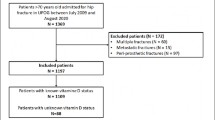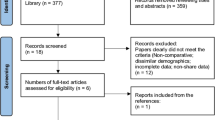Abstract
Summary
Hip fractures are common in the elderly, and many patients with hip fractures have low vitamin D levels. This study found that severe vitamin D deficiency is linked to poorer recovery of function and quality of life after hip fracture surgery.
Introduction
Vitamin D deficiency is prevalent in hip fracture patients and associated with increased mortality and complications. However, there is limited long-term data on how vitamin D levels affect functional outcomes after hip fracture surgery. The aim of this study is to ascertain the association between vitamin D levels and recovery from hip surgery.
Methods
Patients who underwent hip fracture surgery from January 2012 to December 2016 and had vitamin D levels assessed during admission were included. Retrospective analysis was performed on patients’ demographic data such as age, gender and clinical parameters such as preoperative vitamin D, haemoglobin levels, Charlson Comorbidity Index (CCI), and type and site of surgery. Patients were divided according to four different vitamin D levels—severe vitamin D deficiency (≤10 ng/mL), mild deficiency (10-20 ng/ml), insufficiency (20-30 ng/ml), and normal (>30ng/ml). Functional outcomes were measured by Harris Hip Score (HHS), Parker Mobility Score (PMS), and individual domains of 36-Item Short Form Health Survey (SF36). Univariate and multivariate analyses were conducted to examine the association between vitamin D deficiency and functional outcome scores.
Results
Out of 664 patients identified, 9% had severe vitamin D deficiency and 39% mild deficiency. Patients with severe vitamin D deficiency had significantly poorer baseline and 6-month PMS and SF36 Physical Functioning (PF). In multivariate analysis, severe vitamin D deficiency was associated with lower 6-month PMS and SF36 PF.
Conclusion
Preoperative severe vitamin D deficiency is an independent risk factor for poorer recovery of function and quality of life after hip fracture surgery.
Similar content being viewed by others
Data availability
The datasets used and/or analysed during the current study are available from the corresponding author on reasonable request.
References
Papadimitriou N, Tsilidis KK, Orfanos P, Benetou V, Ntzani EE, Soerjomataram I, Künn-Nelen A, Pettersson-Kymmer U, Eriksson S, Brenner H, Schöttker B, Saum KU, Holleczek B, Grodstein FD, Feskanich D, Orsini N, Wolk A, Bellavia A, Wilsgaard T, Jørgensen L, Boffetta P, Trichopoulos D, Trichopoulou A (2017) Burden of hip fracture using disability-adjusted life-years: a pooled analysis of prospective cohorts in the CHANCES consortium. Lancet Public Health 2:e239–e246
Holick MF (2007) Vitamin D deficiency. N Engl J Med 357:266–281
Bouillon R, Marcocci C, Carmeliet G, Bikle D, White JH, Dawson-Hughes B, Lips P, Munns CF, Lazaretti-Castro M, Giustina A, Bilezikian J (2019) Skeletal and extraskeletal actions of vitamin d: current evidence and outstanding questions. Endocr Rev 40:1109–1151
Lee G-H, Lim J-W, Park Y-G, Ha Y-C (2015) Vitamin D deficiency is highly concomitant but not strong risk factor for mortality in patients aged 50 year and older with hip fracture. J Bone Metab 22:205–209
Fakler JKM, Grafe A, Dinger J, Josten C, Aust G (2016) Perioperative risk factors in patients with a femoral neck fracture - influence of 25-hydroxyvitamin D and C-reactive protein on postoperative medical complications and 1-year mortality. BMC Musculoskelet Disord 17:51
Nurmi-Lüthje I, Lüthje P, Kaukonen J-P, Kataja M (2015) Positive effects of a sufficient pre-fracture serum vitamin D level on the long-term survival of hip fracture patients in finland: a minimum 11-year follow-up. Drugs Aging 32:477–486
Schaller F, Sidelnikov E, Theiler R, Egli A, Staehelin HB, Dick W, Dawson-Hughes B, Grob D, Platz A, Can U, Bischoff-Ferrari HA (2012) Mild to moderate cognitive impairment is a major risk factor for mortality and nursing home admission in the first year after hip fracture. Bone 51:347–352
Fisher A, Fisher L, Srikusalanukul W, Smith PN (2018) Usefulness of simple biomarkers at admission as independent indicators and predictors of in-hospital mortality in older hip fracture patients. Injury 49:829–840
Carrillo González I, Martínez-Ramírez MJ, Tenorio Jiménez C et al (2020) 25-hydroxyvitamin D levels in the early healing of osteoporotic hip fracture and their relationship with clinical outcome. Nutr Hosp 37(2):327–334. https://doi.org/10.20960/nh.02427
Giustina A, Adler RA, Binkley N, Bouillon R, Ebeling PR, Lazaretti-Castro M, Marcocci C, Rizzoli R, Sempos CT, Bilezikian JP (2019) Controversies in vitamin D: summary statement from an international conference. J Clin Endocrinol Metab 104:234–240
Di Monaco M, Castiglioni C, Di Carlo S et al (2019) Classes of vitamin D status and functional outcome after hip fracture: a prospective, short-term study of 1350 inpatients. Eur J Phys Rehabil Med 55:56–62
Toldy E, Salamon A, Kálmán B et al (2018) Prognostic relevance of circulating 25OHD fractions for early recovery and survival in patients with hip fracture. J Clin Med Res 7:193. https://doi.org/10.3390/jcm7080193
Fischer K, Trombik M, Freystätter G, Egli A, Theiler R, Bischoff-Ferrari HA (2019) Timeline of functional recovery after hip fracture in seniors aged 65 and older: a prospective observational analysis. Osteoporos Int 30:1371–1381
LeBoff MS, Hawkes WG, Glowacki J et al (2008) Vitamin D-deficiency and post-fracture changes in lower extremity function and falls in women with hip fractures. Osteoporos Int 19:1283–1290
Pioli G, Lauretani F, Pellicciotti F, Pignedoli P, Bendini C, Davoli ML, Martini E, Zagatti A, Giordano A, Nardelli A, Zurlo A, Bianchini D, Sabetta E, Ferrari A, Tedeschi C, Lunardelli ML (2016) Modifiable and non-modifiable risk factors affecting walking recovery after hip fracture. Osteoporos Int 27:2009–2016
Bolland MJ, Grey A, Avenell A (2018) Effects of vitamin D supplementation on musculoskeletal health: a systematic review, meta-analysis, and trial sequential analysis. Lancet Diabetes Endocrinol 6:847–858
Kennel KA, Drake MT, Hurley DL (2010) Vitamin D deficiency in adults: when to test and how to treat. Mayo Clin Proc 85:752–757 quiz 757–8
Sim YE, Sim S-ED, Seng C, Howe TS, Koh SB, Abdullah HR (2018) Preoperative anemia, functional outcomes, and quality of life after hip fracture surgery. J Am Geriatr Soc 66:1524–1531
Bischoff-Ferrari HA, Can U, Staehelin HB, Platz A, Henschkowski J, Michel BA, Dawson-Hughes B, Theiler R (2008) Severe vitamin D deficiency in Swiss hip fracture patients. Bone 42:597–602
Lakkireddy M, Mudavath SV, Karra ML, Arora AJ (2019) Hypovitaminosis D in patients with osteoporotic hip fractures. J Clin Orthop Trauma 10:768–773
Sharma DK, Sawyer RK, Robertson TS et al (2019) Elevated serum 25-hydroxyvitamin D levels are associated with improved bone formation and micro-structural measures in elderly hip fracture patients. J Clin Med Res 8:–1988. https://doi.org/10.3390/jcm8111988
Stewart CC, O’Hara NN, Orwig D et al (2019) Serum 25(OH)D is associated with an altered bone turnover marker response after a hip fracture. J Orthop Res 37:535–540
Code availability
Not applicable
Author information
Authors and Affiliations
Corresponding author
Ethics declarations
Ethics approval and consent to participate
This study involves human data, and institutional review board approval was obtained (Singhealth CIRB 2015/2134) before the start of this single-centre retrospective cohort study. All procedures performed in studies involving human participants were in accordance with the ethical standards of the institutional and/or national research committee and with the 1964 Helsinki declaration and its later amendments or comparable ethical standards. Waiver of consent was approved for this type of retrospective study with anonymized patient records.
Conflicts of interest
None.
Additional information
Publisher’s note
Springer Nature remains neutral with regard to jurisdictional claims in published maps and institutional affiliations.
Rights and permissions
About this article
Cite this article
Sim, D., Tay, K., Howe, T. et al. Preoperative severe vitamin D deficiency is a significant independent risk factor for poorer functional outcome and quality of life 6 months after surgery for fragility hip fractures. Osteoporos Int 32, 2217–2224 (2021). https://doi.org/10.1007/s00198-021-05970-y
Received:
Accepted:
Published:
Issue Date:
DOI: https://doi.org/10.1007/s00198-021-05970-y




